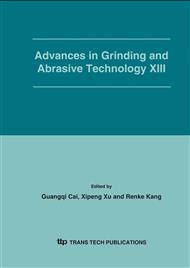p.330
p.335
p.340
p.345
p.350
p.355
p.359
p.364
p.369
Research on Effects of Slurry Additives in Cu CMP for ULSI Manufacturing
Abstract:
In this paper, in order to analyze the oxidation, dissolution and corrosive inhibition effects of additives in the slurry for copper Chemical-mechanical polishing(CMP), the slurry(pH5) with the peroxide as an oxidant, the citric acid as a complexing agent and the benzotriazole(BTA) as an inhibitor is studied. The static etching rate and polishing rate of the Cu-H2O2-Citric acid-BTA slurry are measured. The electrochemical behavior involved in the dissolution and corrosive inhibition of copper in the solutions containing additives is investigated by the electrochemical impedance spectroscopy (EIS) studies. The surface roughness is measured using ZYGO 3-D surface profiler. It is observed that when the slurry is with only 5wt% peroxide existing, copper is stable and slight etching rate on the copper is produced, and the etching rate is only 8.7nm/min. When 0.6wt% citric acid presents after adding 5wt% hydrogen peroxide, the etching rate will increase by 5.3 times, with a blue complexing product emerging. When the inhibitor BTA is added, the corrosion will be effectively restrained. From the EIS results, the impedance of copper in 5wt% peroxide solution which is in passivation can be greatly decreased by adding the citric acid as a complexing reagent. And the impedance of copper in the solution containing peroxide and citric acid can be increased by the addition of BTA. The surface roughness of the wafer polished with the slurry of 5wt% peroxide+0.6wt% citric acid+0.12wt% BTA slurry is Ra 4.7 Å.
Info:
Periodical:
Pages:
350-354
Citation:
Online since:
February 2006
Authors:
Keywords:
Price:
Сopyright:
© 2006 Trans Tech Publications Ltd. All Rights Reserved
Share:
Citation:


